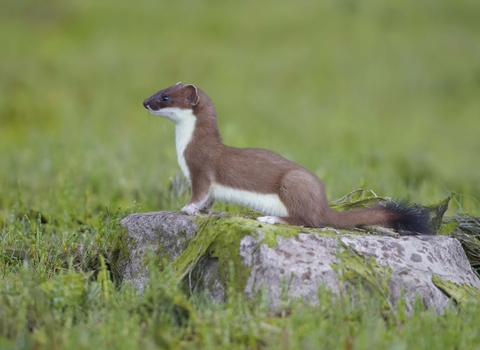
Stoat © Margaret Holland

©Richard Steel/2020VISION
Stoat
Scientific name
Mustela ermineaWhen to see
January to DecemberSpecies information
About
The stoat is a small predator, with a long, low-slung body that makes it particularly well suited to hunting small rodents and rabbits. It can easily kill an adult rabbit, which is much larger than itself, with a bite to the base of the skull. Stoats are active by day and night, and are easiest to spot in open habitats, such as sand dunes, grassland and heathland. They mate in summer, but delay implantation of the fertilised egg until the spring of the following year. They have one litter of six to twelve kits a year.How to identify
The stoat has an orangey-brown back, a creamy white throat and belly, and a black-tipped tail. It is larger than the similar weasel, has a longer tail and has a distinctive bounding gait, arching its back as it moves; weasels do not bound, but run close to the ground.Distribution
Widespread, found throughout the country, although absent from some Scottish islands, the Isles of Scilly and most of the Channel Islands.In our area
Stoats are the only truly native member of the mustelids (weasel) family present on the Isle of Man. As with the mountain hare, stoats should moult in autumn to an all-white coat (the true ermine coat) for improved camouflage in the winters snow but here on the Isle of Man the stoats retain a dark brown winter coat, in the same way as the Irish race of stoats. Recent records of this animal have been scarce and it is believed that they may be on the decline – so if you are lucky enough to spot one, please get in touch.
Did you know?
In the winter, stoats living in colder climes may turn almost completely white, with just a black tip to the tail. This is known as 'ermine' and the fur is extra dense to help them keep warm. Stoats in warmer parts of the UK may not change colour at all, or may take on a 'patchy' appearance.Stoats are the only truly native member of the mustelids (weasel) family present on the Isle of Man. As with the mountain hare, stoats should moult in autumn to an all-white coat (the true ermine coat) for improved camouflage in the winters snow but here on the Isle of Man the stoats retain a dark brown winter coat, in the same way as the Irish race of stoats. Recent records of this animal have been scarce and it is believed that they may be on the decline – so if you are lucky enough to spot one, please get in touch.
